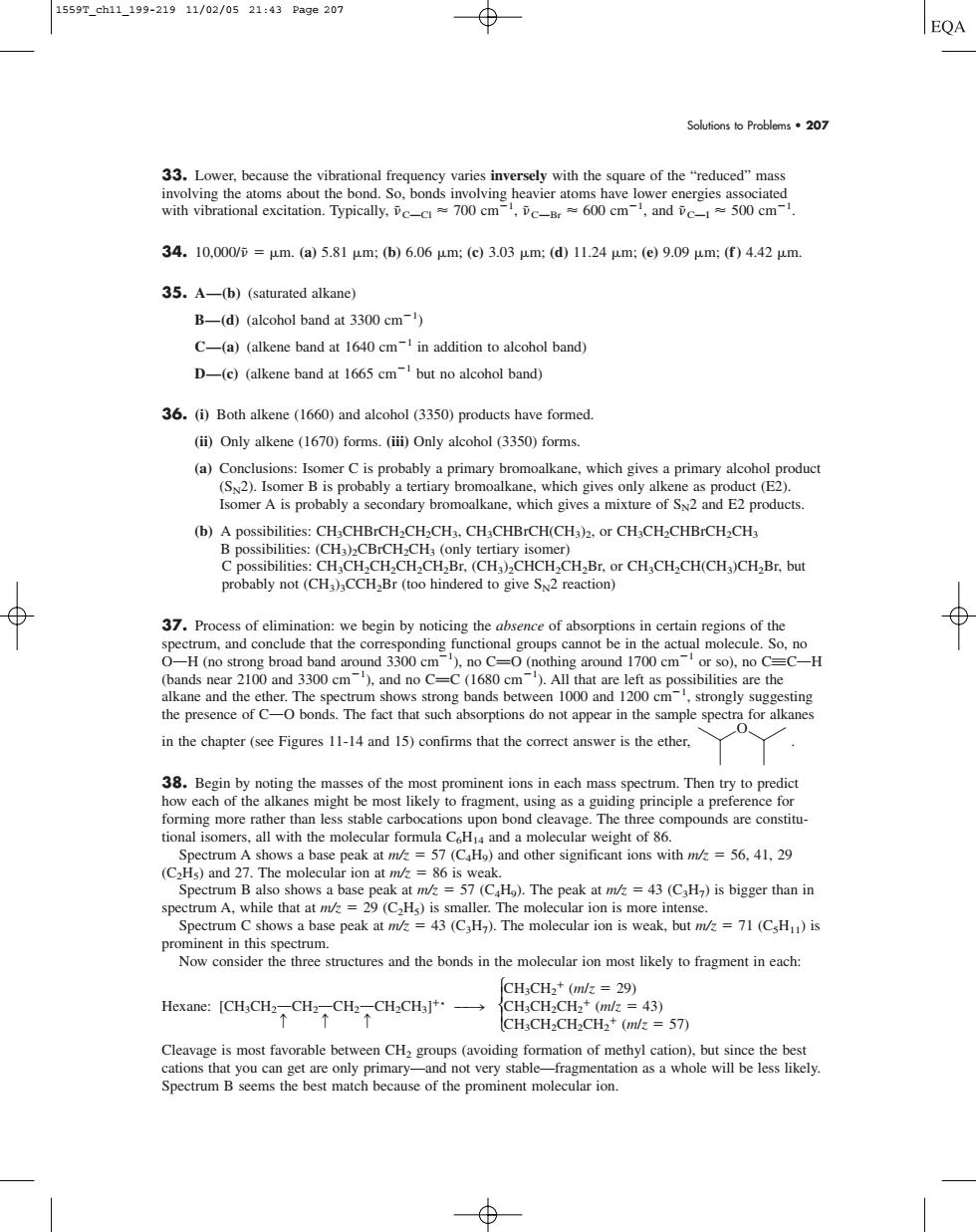正在加载图片...

15597.ch11.199-21911/02/0521:43Page207 ⊕ Solutions o Problems27 33.Lower,because the vibrational frequency varies inversely with the square of the"reduced"mass 34.10,.000=um.(a5.81μm:(b)6.06m()3.03um(d11.24μm(e)9.09umf)4.42μm 35.A-(b)(saturated alkane) B-(d)(alcohol band at 3300 cm-) C-(a)(alkene band at 1640 cm-in addition to alcohol band) D-(e)(alkene band at 1665 cm but no alcohol band) 36.(i)Both alkene (1660)and alcohol (3350)products have formed (ii)Only alkene(1670)forms.(iii)Only alcohol(3350)forms. (a)Conclusions:Isomer C is probably a primary bromoalkane,which gives a primary alcohol product (b)A possibilities:CHaCHBrCH.CH-CH3.CH;CHBrCH(CH3)2.or CH;CH2CHBrCH2CHs (CH)CHCH.CHBr or CH,CH.CH(but probably not (CH)CCH,Br (too hindered to give S2 reaction) 37.Process of elimination:we begin by noticing the of absorptions in certain regions of the mand con d3300 rups cannot (bands near 2100 and 3300 cm)and no C-C(1680 cm).All that are bonds.The strongly absorptions do not appear in th e sample spectra in the chapter (see Figures 11-14 and 15)confirms that the correct answer is the ether. 38.Begin by noting the masses of the most prominent ions in each mas s spectrum.Then try to predict mostkeytofngmcs3sagmitnpinciplaprfercnC orming moThe three】 mA shows a base peak(CH)and other significant ions withm56.41.29 e迎sC时怎C方 spectrum A,wh e molecular ion is more intens Spectrum n C shows a base peak at m/=43 (C:H )The molecular ion is weak,but m/=71 (CH)is Now dhereestructuresand the bonds in the moecular n most likelytoframen in ech Hexame:[CH.CHCHCH CHCH.]" 29 43) CH CH-CH-CH2+(m/=57) Spectrum B seems the best match because of the prominent molecular ion.Solutions to Problems • 207 33. Lower, because the vibrational frequency varies inversely with the square of the “reduced” mass involving the atoms about the bond. So, bonds involving heavier atoms have lower energies associated with vibrational excitation. Typically,
˜ COCl 700 cm1 ,
˜ COBr 600 cm1 , and
˜ COI 500 cm1 . 34. 10,000/
˜ m. (a) 5.81 m; (b) 6.06 m; (c) 3.03 m; (d) 11.24 m; (e) 9.09 m; (f ) 4.42 m. 35. A—(b) (saturated alkane) B—(d) (alcohol band at 3300 cm1 ) C—(a) (alkene band at 1640 cm1 in addition to alcohol band) D—(c) (alkene band at 1665 cm1 but no alcohol band) 36. (i) Both alkene (1660) and alcohol (3350) products have formed. (ii) Only alkene (1670) forms. (iii) Only alcohol (3350) forms. (a) Conclusions: Isomer C is probably a primary bromoalkane, which gives a primary alcohol product (SN2). Isomer B is probably a tertiary bromoalkane, which gives only alkene as product (E2). Isomer A is probably a secondary bromoalkane, which gives a mixture of SN2 and E2 products. (b) A possibilities: CH3CHBrCH2CH2CH3, CH3CHBrCH(CH3)2, or CH3CH2CHBrCH2CH3 B possibilities: (CH3)2CBrCH2CH3 (only tertiary isomer) C possibilities: CH3CH2CH2CH2CH2Br, (CH3)2CHCH2CH2Br, or CH3CH2CH(CH3)CH2Br, but probably not (CH3)3CCH2Br (too hindered to give SN2 reaction) 37. Process of elimination: we begin by noticing the absence of absorptions in certain regions of the spectrum, and conclude that the corresponding functional groups cannot be in the actual molecule. So, no OOH (no strong broad band around 3300 cm1 ), no CPO (nothing around 1700 cm1 or so), no CqCOH (bands near 2100 and 3300 cm1 ), and no CPC (1680 cm1 ). All that are left as possibilities are the alkane and the ether. The spectrum shows strong bands between 1000 and 1200 cm1 , strongly suggesting the presence of COO bonds. The fact that such absorptions do not appear in the sample spectra for alkanes in the chapter (see Figures 11-14 and 15) confirms that the correct answer is the ether, . 38. Begin by noting the masses of the most prominent ions in each mass spectrum. Then try to predict how each of the alkanes might be most likely to fragment, using as a guiding principle a preference for forming more rather than less stable carbocations upon bond cleavage. The three compounds are constitutional isomers, all with the molecular formula C6H14 and a molecular weight of 86. Spectrum A shows a base peak at m/z 57 (C4H9) and other significant ions with m/z 56, 41, 29 (C2H5) and 27. The molecular ion at m/z 86 is weak. Spectrum B also shows a base peak at m/z 57 (C4H9). The peak at m/z 43 (C3H7) is bigger than in spectrum A, while that at m/z 29 (C2H5) is smaller. The molecular ion is more intense. Spectrum C shows a base peak at m/z 43 (C3H7). The molecular ion is weak, but m/z 71 (C5H11) is prominent in this spectrum. Now consider the three structures and the bonds in the molecular ion most likely to fragment in each: CH3CH2G (m/z 29) Hexane: [CH3CH2OCH2OCH2OCH2CH3]G? 88n CH3CH2CH2G (m/z 43) hhh CH3CH2CH2CH2G (m/z 57) Cleavage is most favorable between CH2 groups (avoiding formation of methyl cation), but since the best cations that you can get are only primary—and not very stable—fragmentation as a whole will be less likely. Spectrum B seems the best match because of the prominent molecular ion. O 1559T_ch11_199-219 11/02/05 21:43 Page 207�����������